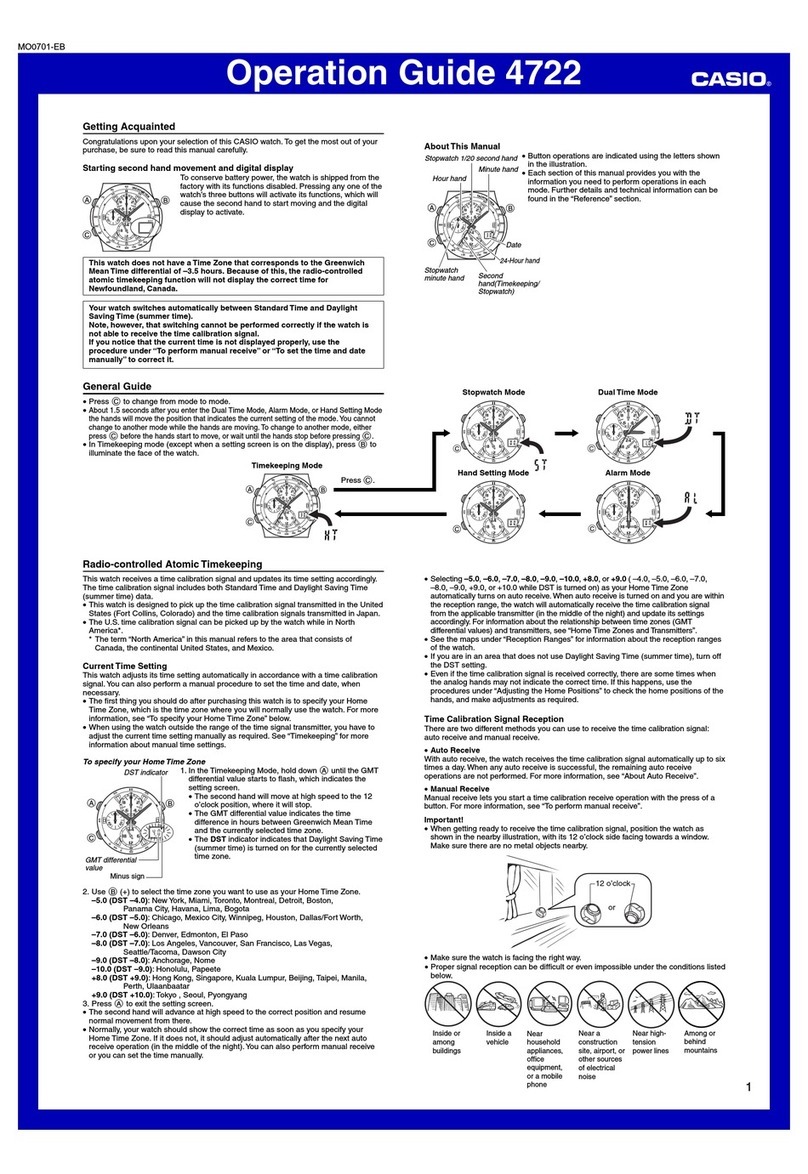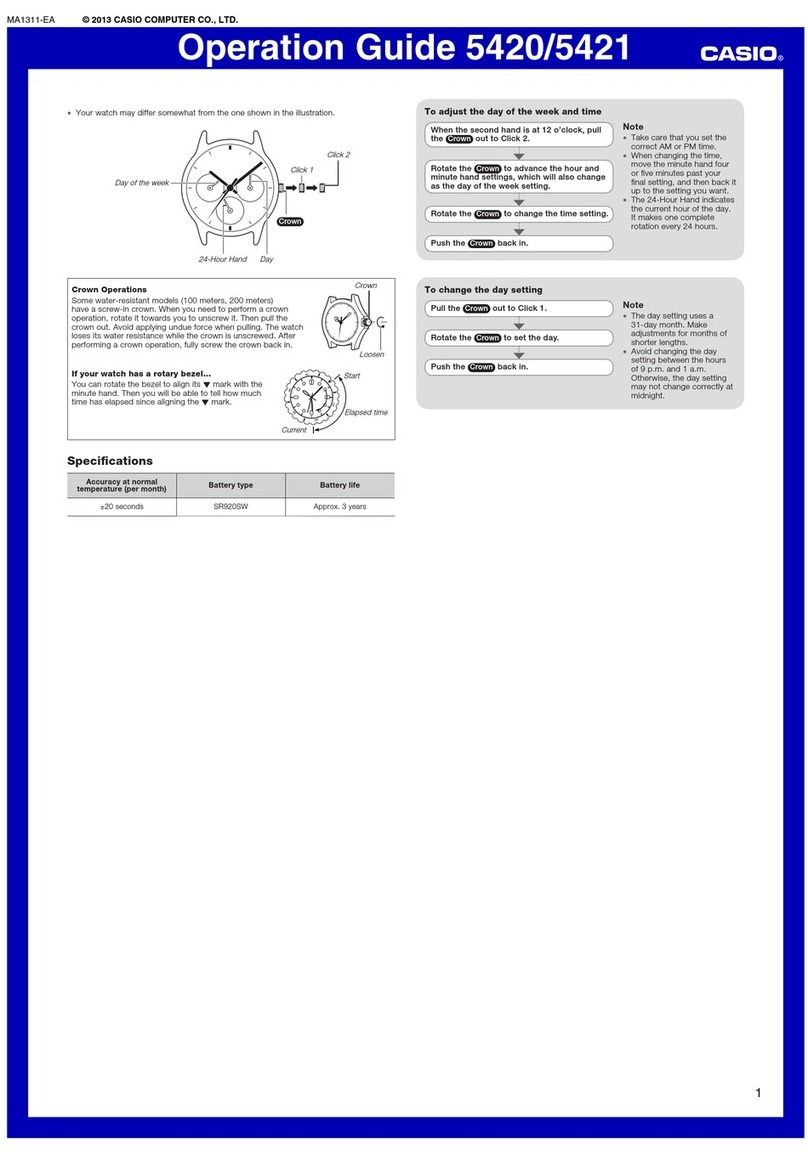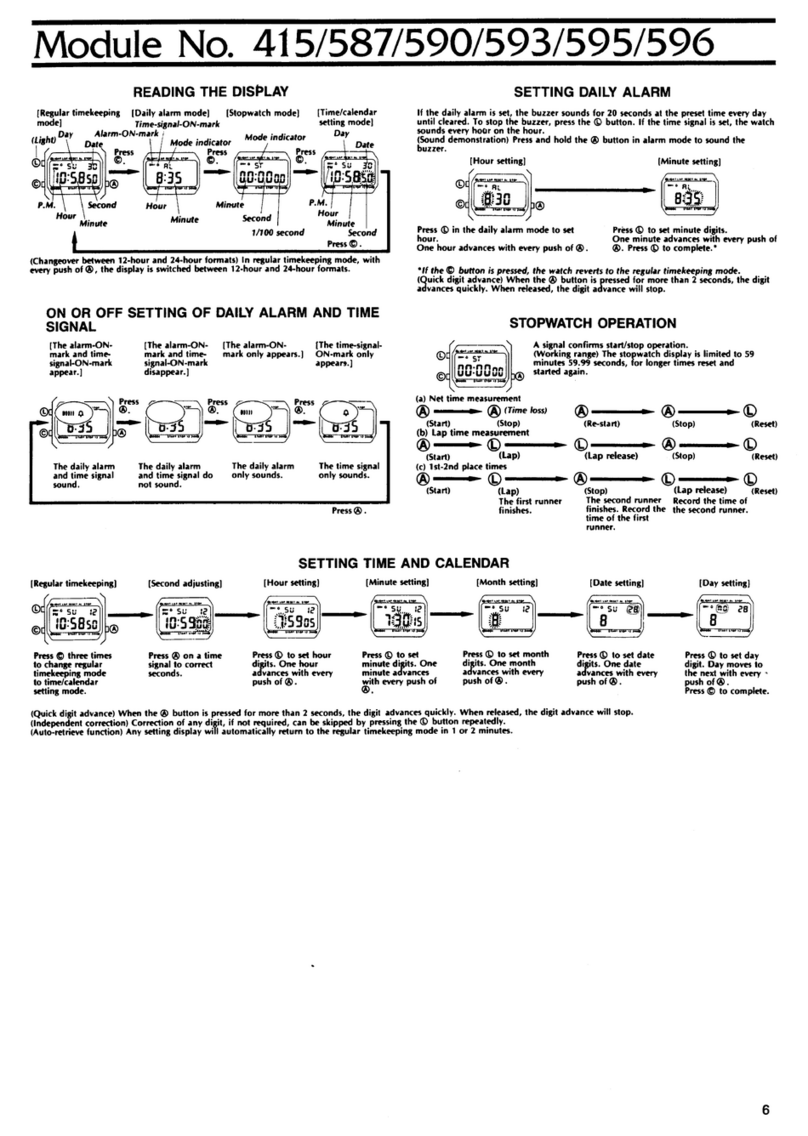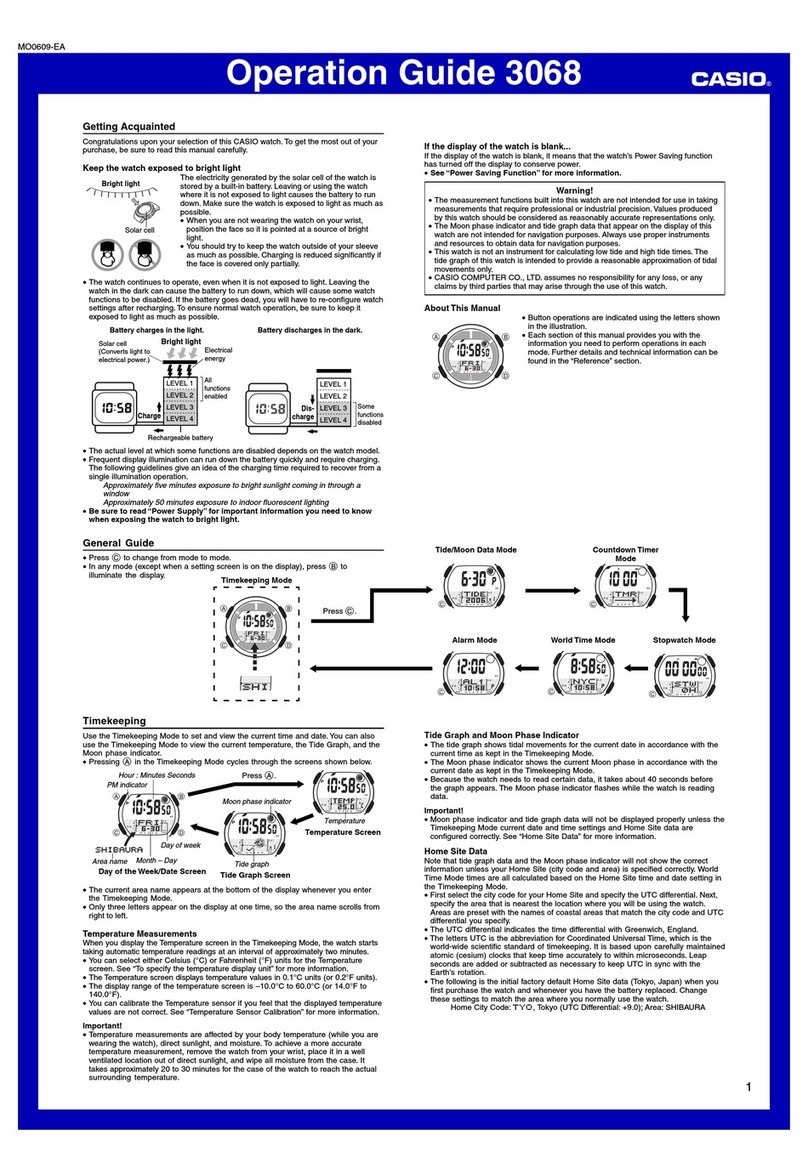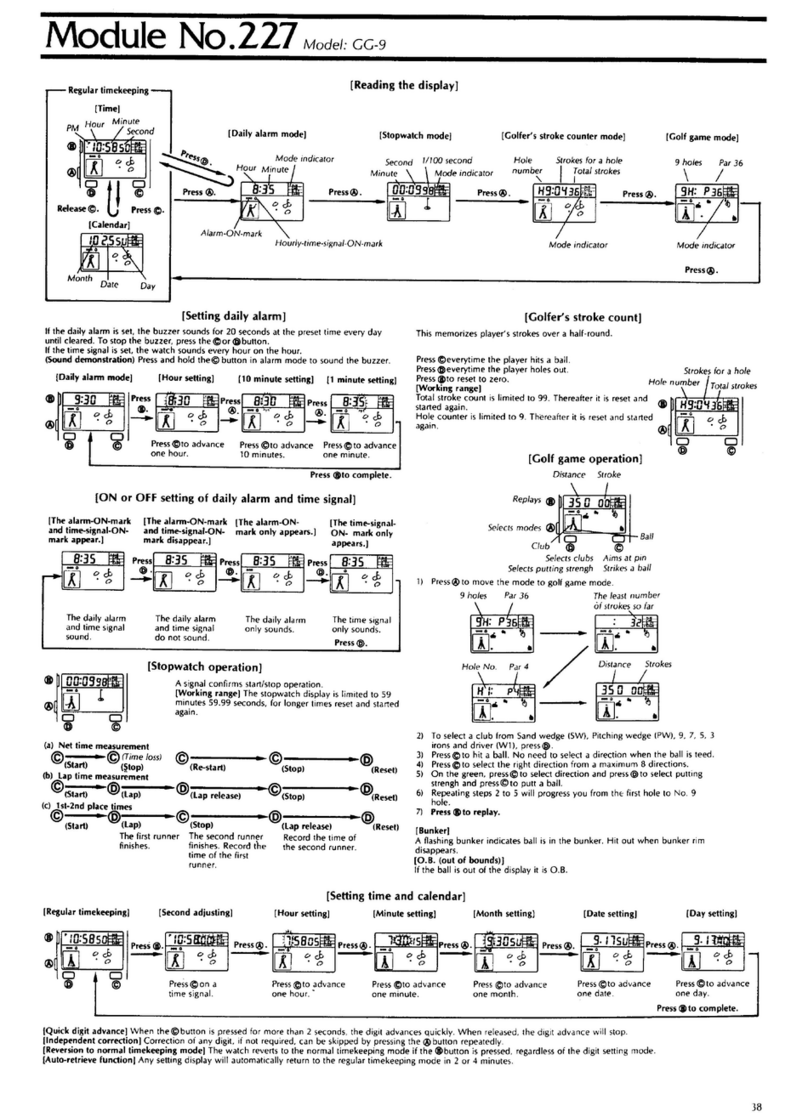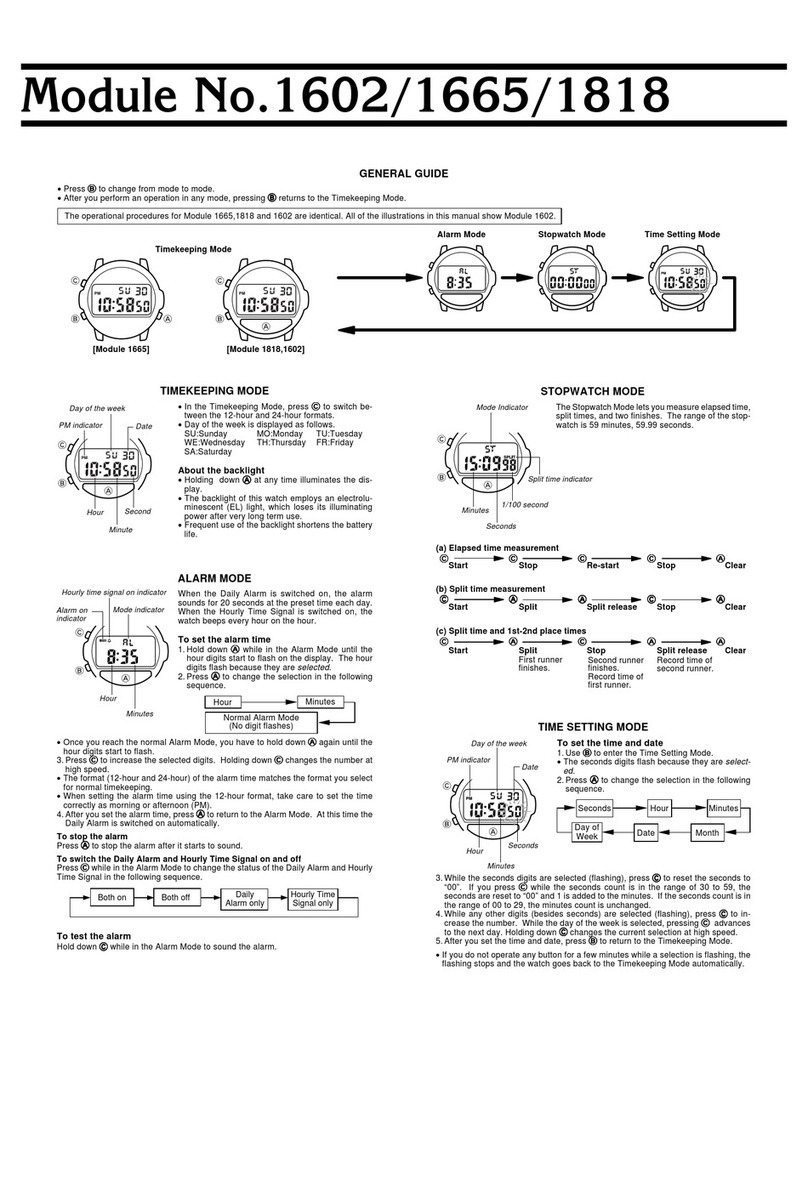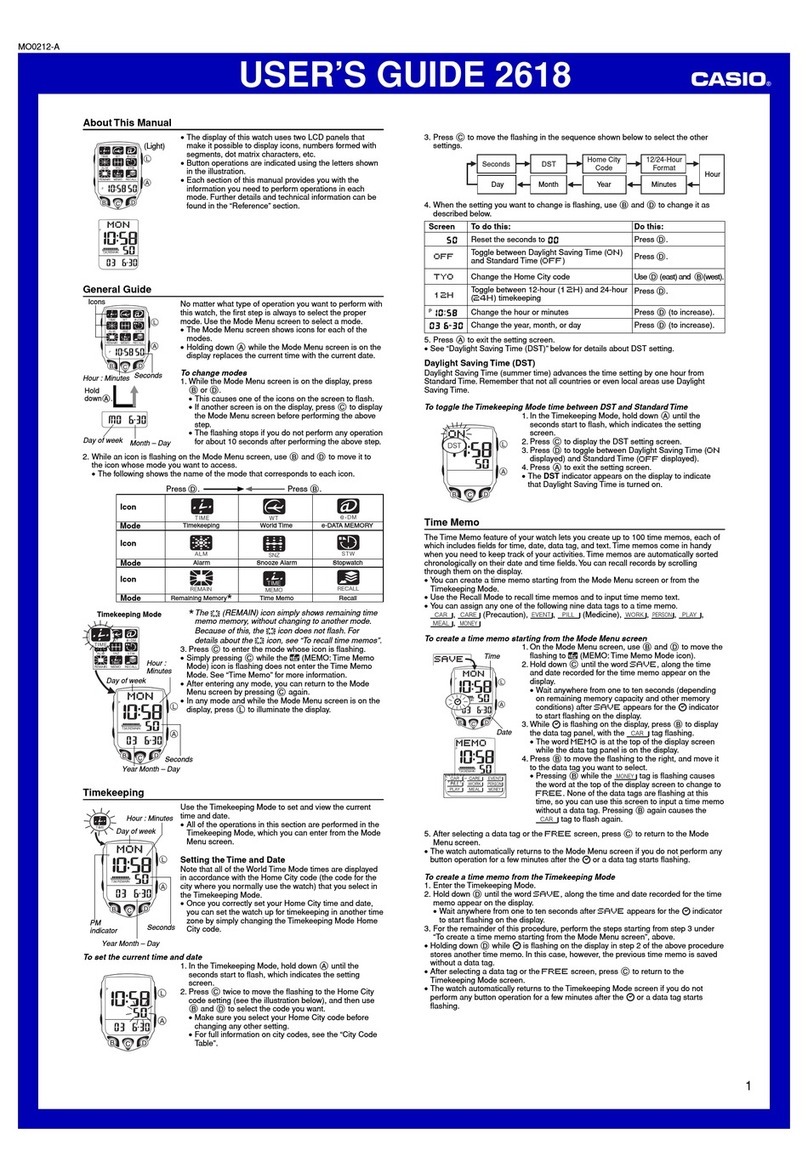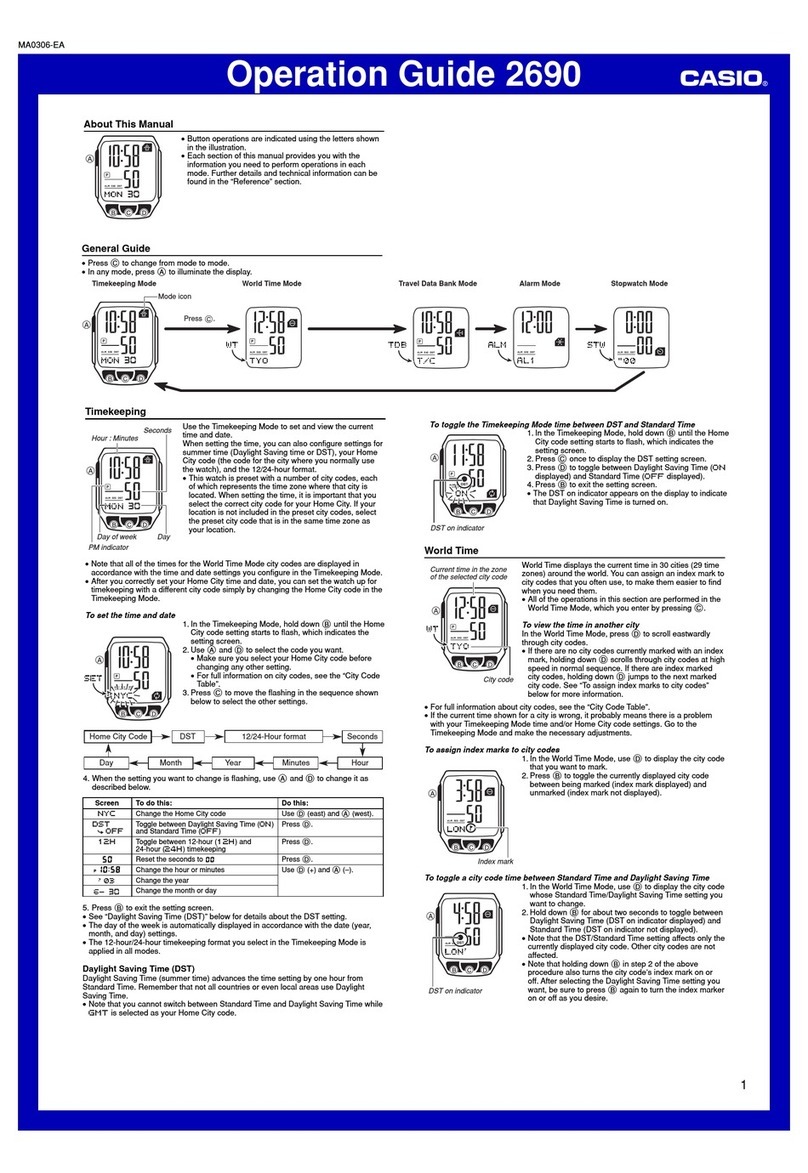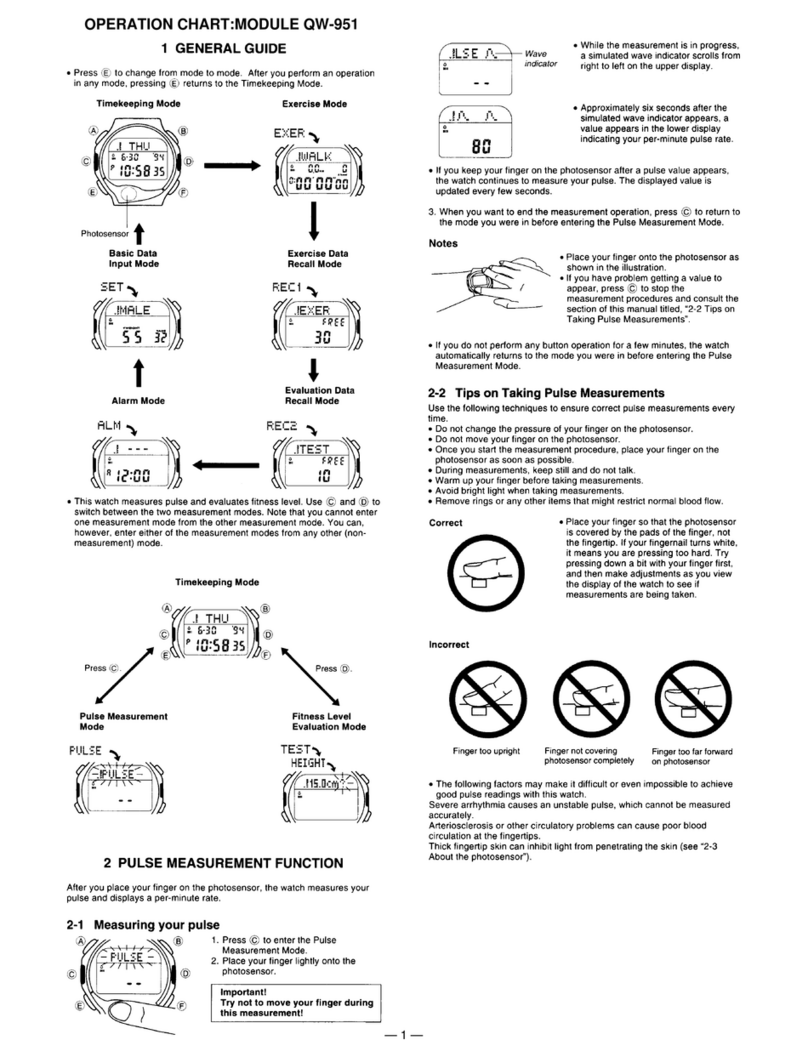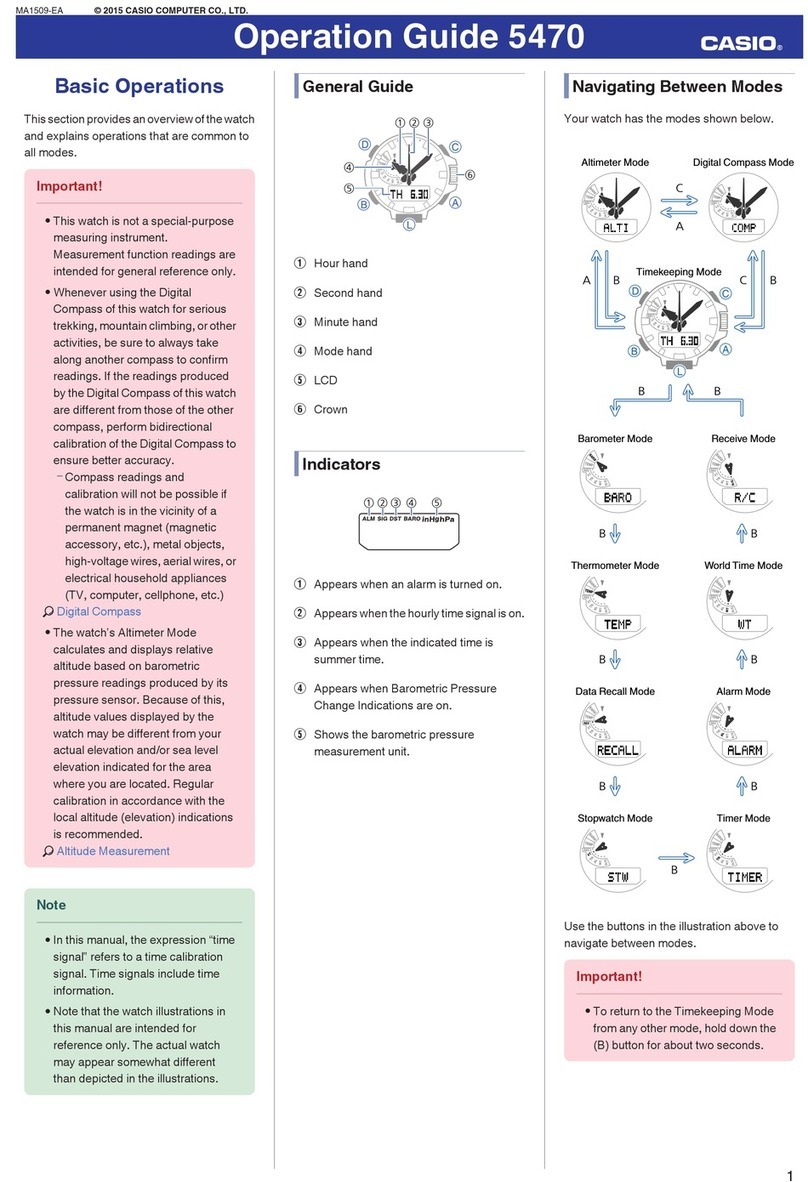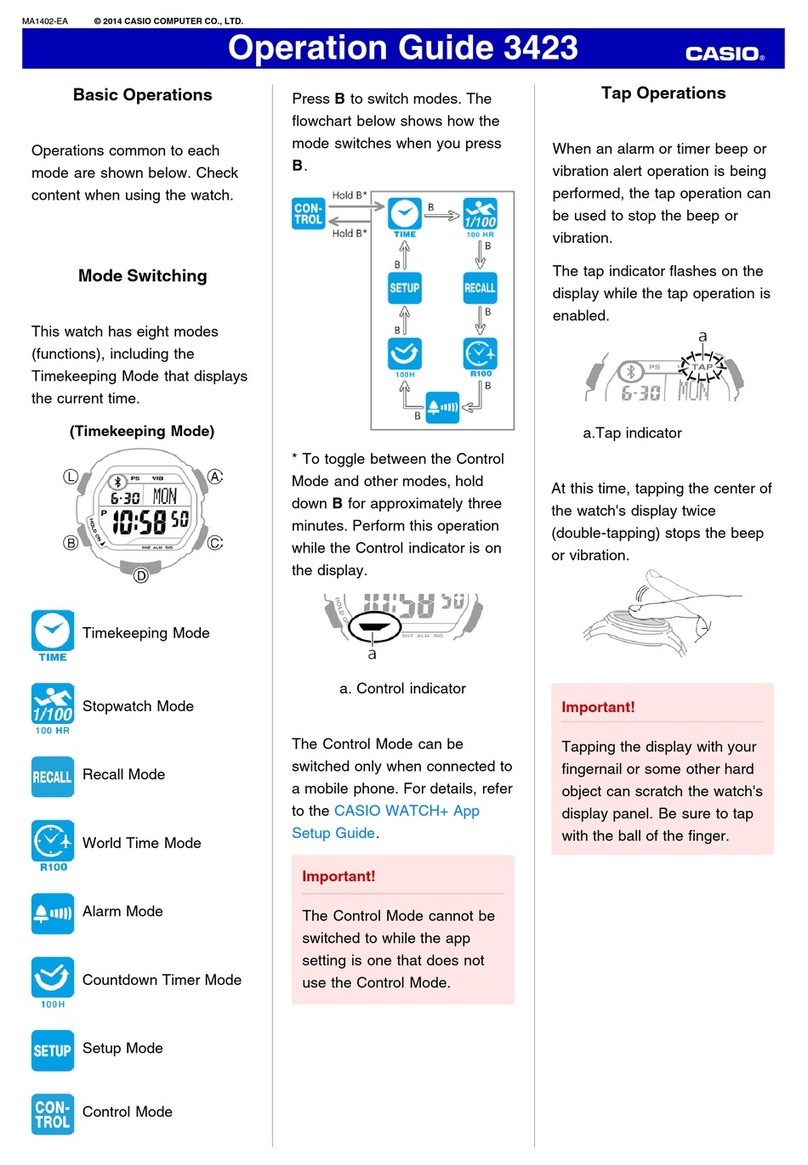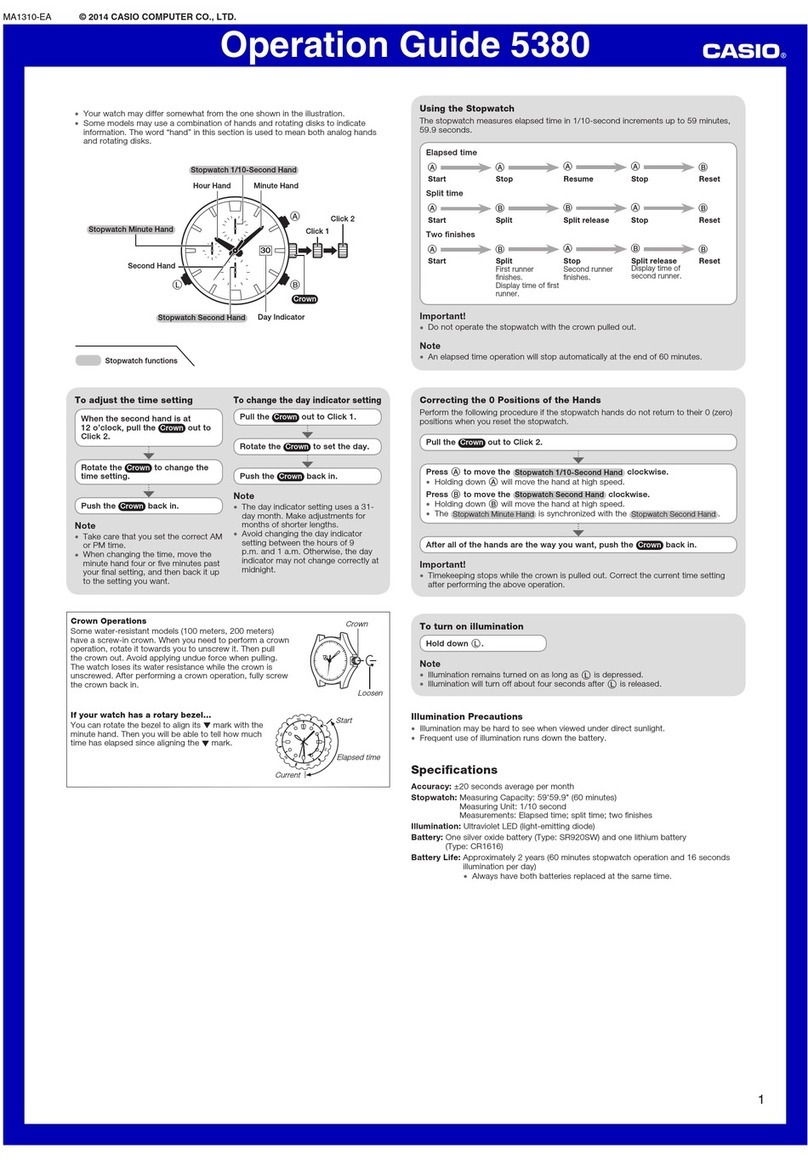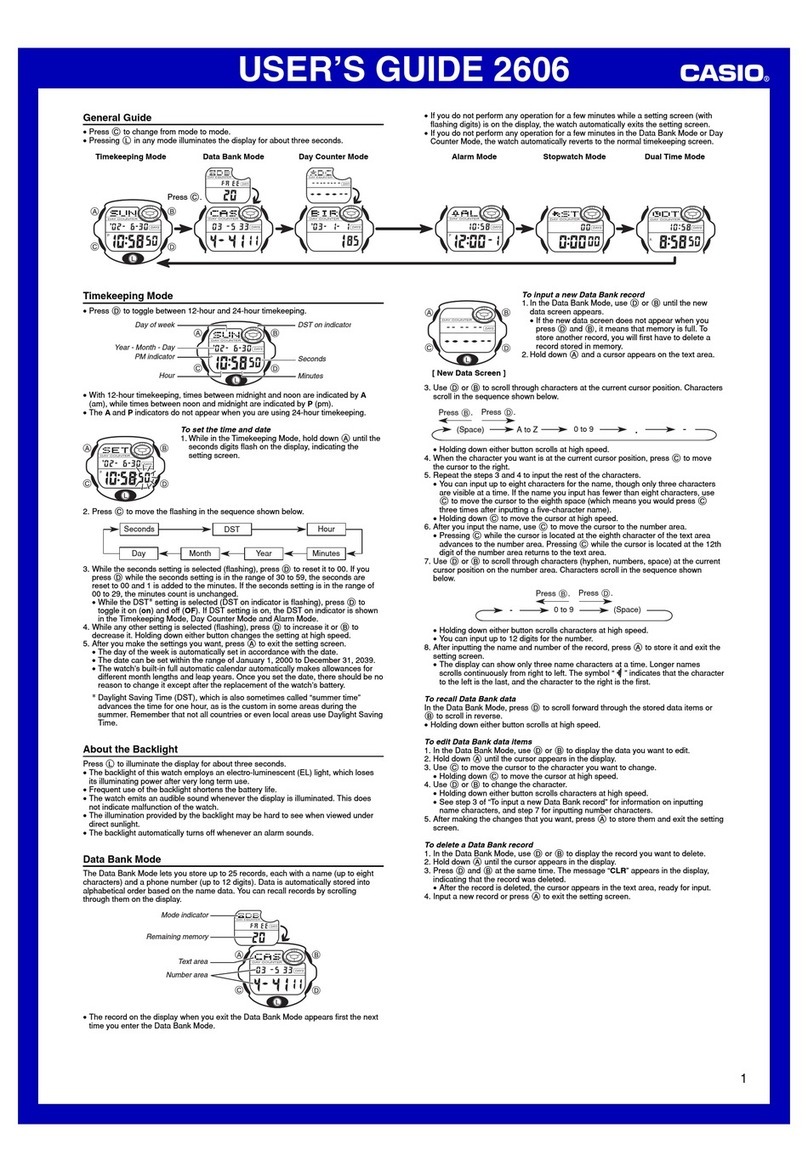
—4 —
To check the result of the last signal
receive operation
In the Timekeeping Mode, press the BB
BB
Bbutton. This enters
the Receive Result Mode.
•If the watch was able to perform a successful signal receive
operation since midnight, the second hand will move to GET. If
the watch has been unable to receive any signal successfully, the
second hand will move to NG.
•To return to the Timekeeping Mode, press the Bbutton three
times.
•
•
•
•
•
•
•
The watch will also return to the Timekeeping Mode if you do not
perform any operation for about two or three minutes.
GET
NG
The current receive result is cleared each day at midnight.
This means GET indicates successful signal reception since
the start of the current day.
•GET continues to be indicated even if an attempt at manual
receive fails after auto receive is successful.
Calibration Signal Reception
Precautions
Auto reception can be performed while the watch is in the
Timekeeping Mode only.
If the hands become misaligned for some reason, they may not
indicate the correct time, even if the time calibration signal is
received normally. If this happens, use the procedure under
“Adjusting the Home Positions”to adjust the home positions of the
hands and the date.
Pressing any button while auto reception is in progress will cause
the watch to beep and signal reception to stop.
Make sure you are within the range of the calibration signal
transmitter before performing the reception operation. Remember
that geographic contours, nearby buildings, seasonal conditions,
the time of day, can even make reception impossible even when
you are within range of the transmitter.
Proper reception may be impossible if there is something blocking
the signal. If reception is unsuccessful, try again.
This watch is designed to adjust its current time setting in
accordance with the calibration signal transmitted in Japan only. It
operates like a standard (non-radio controlled) watch outside of
the range of the receivable time calibration signal transmitters.
When the watch is unable to receive the time calibration signal for
some reason, timekeeping accuracy is within ±20 seconds per
month.
Strong electrostatic charge can cause timekeeping error.
Signal reception is cancelled if the alarm starts to sound while it is
being performed.
The watch’s calendar shows dates up to the year 2099.
Attempting a receive operation after that causes an error.
Receiving the Calibration Signal
There are two methods you can use to receive the time calibration
signal.
Auto receive (Reception is performed automatically at midnight,
1:00, 2:00, 3:00, 4:00 and 5:00 each morning.)
Manual receive (You initiate reception using a button operation.)
•When any auto receive is successful, further auto receive
operations for that day are not performed.
•Successful auto receive keeps timekeeping accurate.
To position the watch for optimum
reception
Remove the watch from your wrist and place it somewhere so its
right side (9 o’clock side, where the antenna is located) is facing a
window.
9 o’clock
side
Or
•Do not move the watch while it is receiving the calibration signal.
Time Required for Reception
A calibration signal receive operation takes anywhere from about
two to seven minutes.
To perform manual receive
In the Timekeeping Mode, hold
down the BB
BB
Bbutton for about
two seconds.
The watch will beep, and signal
reception will start.
To interrupt reception
Press any button.
When reception starts
The second hand moves to READY.
The hour and minute hands continue to keep time normally.
During reception
The second hand moves to WORK.
The hour and minute hands continue to keep time normally.
Do not move the watch until calibration signal reception is complete.
After reception is complete
If reception is successful, the second hand will move to GET. One
or two minutes later, the hands will move to the correct time.
If reception is not successful, the second hand will move to NG
(No Good). One or two minutes later, the second hand will resume
normal operation, without any adjustment of the hand setting.
Press the AA
AA
Abutton.
This will cause the minute hand
to move counterclockwise about
one or two minutes, and then
stop around 12 o’clock.
Press the BB
BB
Bbutton.
Each press of the Bbutton
moves the setting
counterclockwise by one minute.
Holding down the Bbutton for about two seconds moves the
hands counterclockwise at high speed. High-speed movement of
the hands will continue until it completes a 12-hour cycle, or until
you press any button to stop it.
4.
When the setting is the
way you want, press the
AA
AA
Abutton.
This will cause the hour and
minute hands to move to the
current time, and the second
hand to move to “ON”(alarm
on).
Setting the alarm time causes
the alarm to turn on
automatically.
5.
Press the BB
BB
Bbutton twice
to return to the
Timekeeping Mode.
This causes the second hand
to move to the seconds count
of the current time and
resume normal movement.
If you do not perform any button operation for about two or three
minutes, the watch will exit the setting mode and resume normal
hand movement.
To turn the alarm on or off
In the Alarm Mode, press the
AA
AA
Abutton to toggle the alarm
on and off.
To stop the alarm beeper
Pressing any button while the beeper is sounding stops it.
OFF
ON
You can set an alarm time in 1-minute units. The watch beeps for 10 seconds when the alarm time is reached.
3.
Set the alarm time you want.
•If you want to set the alarm time by moving the hands
clockwise, go to step 3-a.
•If you want to set the alarm time by moving the hands
counterclockwise, go to step 3-b.
When setting the alarm time, take care to set AM and PM
correctly.
•The second hand will move between AM and PM any time
the hour hand moves past 12 o’clock while you are setting
the alarm time.
Press the BB
BB
Bbutton.
•
••
•
•
•
•
•
•
•
•
•
•
•
•
•
•
•
Each press of the Bbutton
moves the setting clockwise by
one minute.
•
Holding down the Bbutton for
about two seconds moves the
hands clockwise at high speed.
High-speed movement of the
hands will continue until it
completes a 12-hour cycle, or until
you press any button to stop it.
•After the alarm time setting is the way you want, press the A
button to advance to step 4.
To set an alarm time
1.
In the Timekeeping Mode,
press the BB
BB
Bbutton twice
to enter the Alarm Mode.
•
•
•
The second hand will move to
either “ON”(alarm on) or
“OFF”(alarm off).
2.
Hold down the AA
AA
Abutton
for five seconds to display
the setting screen.
The second hand will move to
“AM”or “PM”.
Note that the hands do not
move while the alarm setting
screen is on the display.
OFF
ON
AM PM
Example: Midnight
Using the Alarm
■
■
■
■
■
■
■
■
■
To set the alarm time by moving the hands
clockwise
3-a
To set the alarm time by moving the hands
counterclockwise
3-b
■
■


